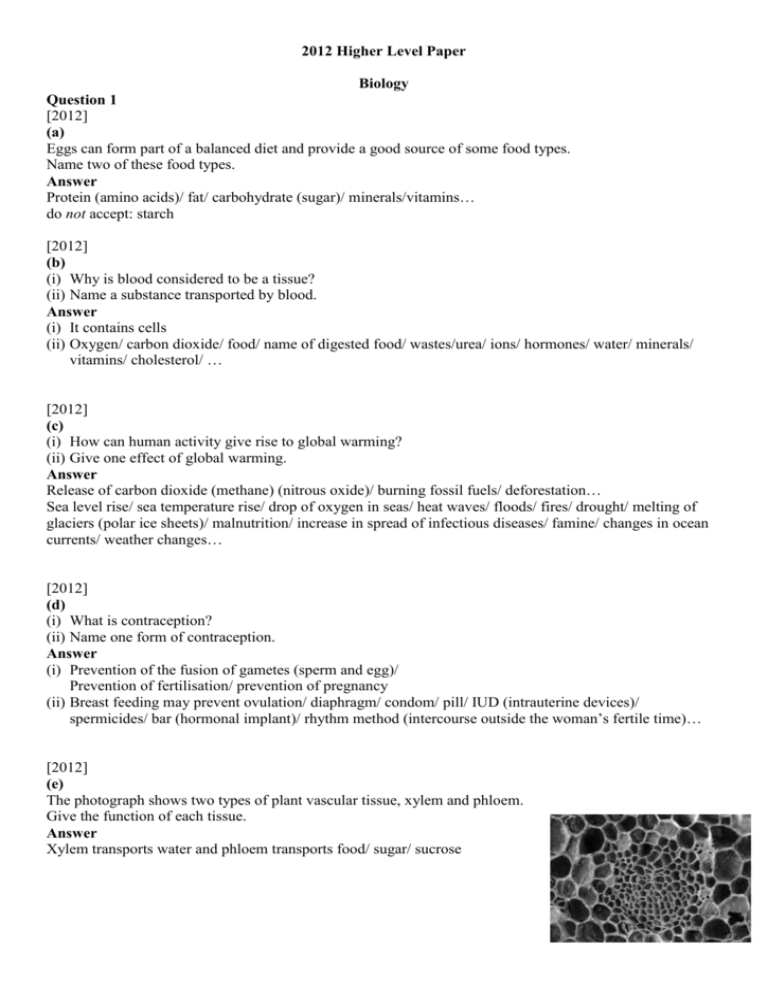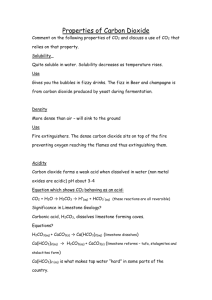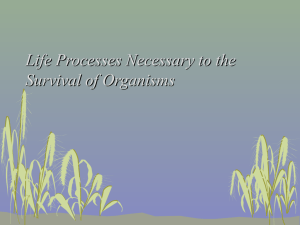2012 - thephysicsteacher.ie
advertisement

2012 Higher Level Paper Biology Question 1 [2012] (a) Eggs can form part of a balanced diet and provide a good source of some food types. Name two of these food types. Answer Protein (amino acids)/ fat/ carbohydrate (sugar)/ minerals/vitamins… do not accept: starch [2012] (b) (i) Why is blood considered to be a tissue? (ii) Name a substance transported by blood. Answer (i) It contains cells (ii) Oxygen/ carbon dioxide/ food/ name of digested food/ wastes/urea/ ions/ hormones/ water/ minerals/ vitamins/ cholesterol/ … [2012] (c) (i) How can human activity give rise to global warming? (ii) Give one effect of global warming. Answer Release of carbon dioxide (methane) (nitrous oxide)/ burning fossil fuels/ deforestation… Sea level rise/ sea temperature rise/ drop of oxygen in seas/ heat waves/ floods/ fires/ drought/ melting of glaciers (polar ice sheets)/ malnutrition/ increase in spread of infectious diseases/ famine/ changes in ocean currents/ weather changes… [2012] (d) (i) What is contraception? (ii) Name one form of contraception. Answer (i) Prevention of the fusion of gametes (sperm and egg)/ Prevention of fertilisation/ prevention of pregnancy (ii) Breast feeding may prevent ovulation/ diaphragm/ condom/ pill/ IUD (intrauterine devices)/ spermicides/ bar (hormonal implant)/ rhythm method (intercourse outside the woman’s fertile time)… [2012] (e) The photograph shows two types of plant vascular tissue, xylem and phloem. Give the function of each tissue. Answer Xylem transports water and phloem transports food/ sugar/ sucrose [2012] (f) Name the two substances that chromosomes are made of. Answer DNA and protein [2012] (g) Asexual and sexual reproduction occurs in plants. State how a named plant can reproduce asexually. Answer Grass/ potato/ strawberry/ onion/ crocus… underground stems (rhizomes)/ tuber/ runner (stolon)/ bulb/ … [2012] (h) (i) Name the type of joint shown in the diagram. (ii) Describe the movements that this type of joint can make. (iii)Explain how muscles cause the movements of this joint. Answer (i) Hinge (ii) backward and forward or up and down (iii)the biceps (muscle) contracts bringing bones closer… the triceps (muscle) contracts bringing bones apart… or antagonistic muscles (biceps & triceps) (pair of muscles) cause movement in opposite directions… Question 2 [2012] (a) The diagram is of the urinary system. Give the function of five of the six parts labelled. Answer Renal artery: brings blood to the kidney Kidney: filters blood/ removes waste/ excretes /makes urine/ cleans blood/ helps water balance… Renal vein: collects blood from the kidney/ returns blood to body (heart) Urethra: carries urine (wastes) (urea) from the kidneys to the bladder Bladder: collects (stores) urine Urethra: releases urine/. allows sperm to leave [2012] (b) (i) The photograph shows part of a leaf of a green plant. Name a gas that moves into and a gas that moves out of a green leaf during active photosynthesis. Answer Gas in: carbon dioxide (CO2) Gas out: oxygen (O2)/ water vapour (H2O) (ii) Outline an experiment to show that photosynthesis produces starch. Answer Cover leaf of plant with aluminium foil Leave plant in dark for some time / de-starch plant Place the plant in bright light for some time Remove chlorophyll (boil in alcohol) Add iodine to leaves Only the leaf which was exposed to light goes blue-black Question 3 [2012] (a) An insect feeds on a flower and picks up pollen. When the insect visits another flower of the same species it leaves some of the original pollen behind. (i) Give a second way in which transfer of pollen between plants occurs. (ii) Draw a labelled diagram of a suitable flower showing the stigma, style, ovary, anther and filament. (iii)Name the part of the flower that produces the male gamete. (iv) Name the part of the plant that produces the female gamete. (v) What follows fertilisation in the flowering plants? Answer (i) Wind/ water/ artificial e.g. using a brush… (ii) Anther (do not accept (‘stamen’) (iii)Ovule (accept ‘ovary’, do not accept ‘carpel’) (iv) Zygote/ seed formation (dispersal)/ fruit formation [2012] (b) Without enzymes we would not be able to exist. Enzymes release energy from food, help build the molecules that our bodies are composed of and break down structures and wastes that we no anger needed (i) Name an enzyme. (ii) Name the substrate that the enzyme you have named acts on. (iii)Name the product of the action of this enzyme. (iv) What reagent might you use, in a laboratory, to test that the reaction has taken place? Answer (i) Amylase (ii) Starch (iii)Maltose (iv) Iodine solution/ Benedict’s solution/ Fehling’s solution Chemistry Question 4 [2012] (a) Alloy car wheels are made from an alloy of aluminium or magnesium. Name another alloy and give a use for it. Answer Solder/ steel/ brass/ bronze… Solder: joining metals/ steel-girders, car bodies, tools, nails, screws, hinges… Brass: plug pins, keys, musical instruments, hinges, screws, door handles… Bronze: sculptures, bells, coins, medals, bearings, springs, hammers, ships propeller… [2012] (b) (i) What substance is formed when carbon is burned in oxygen? (ii) Give the effect of this substance on moist litmus paper. Answer Carbon dioxide/ CO2 Blue turns red [2012] (c) Water has been flowing through the pipe shown in the photograph for some time. The pipe originally had no internal deposit. (i) Give a possible reason for the formation of the deposit. (ii) What do you think the deposit is? Answer (i) Hard water (ii) lime scale/ calcium carbonate/ magnesium carbonate/ correct formula [2012] (d) Using their atomic symbols, arrange the metals, copper, calcium, zinc and magnesium in order of decreasing reactivity with dilute hydrochloric acid. Answer Ca, Mg, Zn, Cu [2012] (e) The diagram shows part of a crystal of sodium Chloride. (i) Name the type of bonding in sodium chloride. (ii) Describe this type of bonding. Answer (i) Ionic (ii) Oppositely charged ions attract [2012] (f) Select a substance from the list with a pH less than 7 and one with a pH greater than 7: orange juice, rain water, toothpaste, bread soda, vinegar, sour milk, milk of magnesia, cola, washing soda. Answer pH less than 7: Orange juice/ rainwater/ vinegar/ sour milk/ cola pH greater than 7: Toothpaste/ bread soda/ milk of magnesia/ washing soda [2012] (g) Name two non-metallic elements. Answer H, He, B, C, N, O, F, Ne, Si, P, S, Cl, Ar, As, Se, Br, Kr, Te, I, Xe, Rn [2012] (h) Paper chromatography was used to find the composition of brown ink in a pen. The same liquid, paper and pen were used in each of the three experiments shown. They were started at different times, C first then B and finally A. (i) Why is the ink dot above the level of the liquid in each beaker? (ii) What caused the dots of ink on the papers B and C to spread upwards? (iii)Why were colours, other than brown, seen in B and C as the ink moved up the paper? Answer (i) Because the ink dot would dissolve into the liquid/ ink would not rise up the paper/ ink soluble (ii) They were carried up by the liquid/ capillarity (iii)The brown ink was a mixture of inks/ made up of different colours Question 5 [2012] (a) An experiment was performed to investigate the effect of temperature on the solubility of carbon dioxide in water. The data obtained from this experiment is given in the table below. Solubility of CO2 (grams of CO2 per kg of water) Temperature (0C) 3.4 0 2.5 10 1.7 20 1.4 30 1.0 40 0.8 50 (i) Draw a graph of solubility against temperature in the grid below using the data from the table. A smooth curve is required. (ii) Usually the solubility of a solid increases with increasing temperature. The solubility of a gas decreases as the temperature increases. Suggest a reason why this decrease happens. (iii)From the graph estimate the temperature at which the solubility of CO2 is 2 g per kg of water. 0.6 60 Answer (i) See graph (ii) Temperature increases the motion of gases/ allow them to escape/ weak attractive forces / gases expand/ gases rise/ gases less dense/ bubbles form/ gas molecules have more energy… (iii)Estimate 16 0C +/- 2 0C [2012] (b) The table gives the % by volume of five gases/ vapours found in our atmosphere. Formula N2 O2 H20 Ar CO2 % Volume 78.08 20.95 0 to 4 0.93 0.036 (i) Which two of these gases/ vapours are produced when a fossil fuel is burned? (ii) The amount of water vapour present in the air is the most variable. Suggest a reason for this. Answer (i) CO2, H2O (ii) Temperature changes/ weather/ evaporation/ rain/ snow/ transpiration/ plants/ respiration/ combustion/ photosynthesis/ specified location… [2012] (c) Describe an experiment, using a labelled diagram to show the presence of carbon dioxide in air. Answer See diagram Draw air through a solution of lime water Result: lime water goes milky [2012] (d) Give a test to show that the droplets formed on the outside of a glass containing a cold drink are water. Answer Use anhydrous (white) copper sulphate – it turns blue Or Blue cobalt chloride paper turns pink Question 6 [2012] (a) The photograph shows a water treatment plant that produces water fit for domestic consumption. Name and describe four processes used in this treatment of water. Answer Name Description Screening removal of large items Flocculation combine (coagulate) small particles into larger particles Sedimentation (settling) particles sink to bottom Filtration Ion exchange filtration clarifies water (remove all particles from the water) (water passed through sand filters remove unwanted dissolved materials pH adjustment Base added to prevent corrosion of pipes/ Adsorption Fluoridation Taste, (colour) and (odour) causing compounds can stick to powder (activated carbon) and are removed/ Help prevent tooth decay add chlorine Kills microorganisms / bacteria… [2012] (b) Bart is doing lines. Most Junior Cert candidates have three years experience of working in a school laboratory. Give two important safety rules that must be followed at all times by everyone in the laboratory. Answer Do not enter the laboratory without permission/ do not use any item without permission/ do not use any item without knowing how to use it/ tie back long hair/ wear eye protection when necessary/ check the label on the container before using some of the contents/ never eat in a laboratory/ if you get something into to your mouth by accident, spit it out and inform your teacher/ any accident must be reported to the teacher immediately/ chemical spills must be reported and cleaned up/ wear a laboratory coat always/ wash chemicals from eyes and skin immediately and report to your teacher/ wash your hands before leaving… [2012] (c) Describe the reaction of a named alkali metal with water and name a product of the reaction. Answer e.g. potassium burns/ flame/ sparks/ explodes… e.g. potassium hydroxide (KOH)/ hydrogen (H2) Physics Question 7 [2012] (a) The diagram shows the evaporation of water. (i) What is evaporation? (ii) What do molecules have to gain in order to evaporate from liquid water? Answer (i) Liquid to gas (vapour) (ii) Energy/ heat [2012] (b) Explain the difference between direct current (dc) and alternating current (ac). Answer dc: flows in one direction ac: flows in one direction and then in the opposite direction/ changes direction do not accept: ‘stays the same’ for dc or ‘changes’ for ac. What ‘stays the same’or ‘changes’ i.e. direction must be specified [2012] (c) What causes the appearance of a ‘second’ drinking straw in the drink in the glass shown in the photograph? Answer Refraction or Light changes direction when it enters and leaves the drink [2012] (d) The conversions of chemical energy to kinetic energy to potential energy occurs when you walk up a stairs. Give two more everyday examples of energy conversions and the contexts in which they occur. Answer Falling down the stairs: potential energy to kinetic energy and sound energy/ Car: chemical energy to kinetic and heat energy/ Photosynthesis: nuclear energy to light energy to chemical energy/ Washing machine: electrical energy to heat, kinetic and sound energy/ Respiration: chemical energy to heat energy and kinetic energy… [2012] (e) The damage to the railway tracks shown in this image was caused by an environmental factor. Name the factor and explain how it caused the damage. Answer Heat (high temperature) Expansion [2012] (f) Three holes were made in a carton of milk at the same time. (i) From which hole will the milk pour out at the greatest rate? (ii) Give a reason for your answer. Answer (i) The hole at the bottom (ii) It is under the greatest pressure [2012] (g) Fuses are used in some electrical circuits for safety. How does a fuse work for our protection? Answer Too much current causes the wire to melt, breaking the circuit. [2012] (h) Renewable energies are shown in the picture. (i) Pick any two of the energies shown in the picture and name your selection. (ii) Give one advantage associated with each energy you’ve selected. Two different reasons must be given. (iii)Give one disadvantage associated with each energy you’ve selected. Two different reasons must be given. Answer Advantages Wind turbines emit no carbon dioxide (CO2) produced/ carbon dioxide (CO2) removed absorbed)/ carbon neutral/. Hydroelectric plants are long-lived Solar heating can provide hot water/ solar power panels supply electricity Tidal generators are submerged (their rotors turn slowly) (sea life is safe)/ wave generators are moored off-shore (just ‘bob up and down’)… Disadvantages Wind turbines, in some areas, are objected to as unsightly (noise) (kill birds) Large solar power plants use a lot of water (need huge area) the rest of this list also applies to solar heating (direction of the sun changes) (changes in seasons) (day to night) (cloud cover ) The construction of hydroelectric plants can cause dislocation of people (release of large amounts of carbon dioxide due cement production required) Biomass uses land that could be used for food production (uses food crops to make biofuels)… do not accept: ‘expensive’ or ‘not expensive’ for (i) or (ii), a definition of renewable energy for (i) e.g. ‘will not run out’. Look for: items (i) & (ii) specific to candidate-selected energies. Question 8 [2012] (a) (i) Define pressure Answer 𝐹𝑜𝑟𝑐𝑒 𝑃𝑟𝑒𝑠𝑠𝑢𝑟𝑒 = 𝐴𝑟𝑒𝑎 [2012] (ii) An experiment was performed to investigate the effect of pressure on the boiling point of water. The data from the experiment is given in the table below. Pressure (kPa) Temperature (0C) 100 100 120 105 140 109 160 14 180 119 200 124 Draw a graph of pressure against temperature using the grid below. Answer (iii)What two pieces of information can be drawn from the graph about the relationship between the boiling point of water and pressure? Answer Boiling point increases with pressure/ The increase in boiling point is proportional to the increase in pressure. (iv) What effect would reducing the pressure on water below normal atmospheric pressure, about 100kPa, have on its boiling point? Answer It would reduce the boiling point. [2012] (b) The kilowatt-hour is the unit electrical energy used by electricity suppliers. The photograph shows a kWh (kilowatt-hour) meter. This meter is connected into the electricity consumer’s domestic circuit and it can measure energy consumption in a selected part of the circuit, the total energy used and cost it. The meter can be wall-mounted in a convenient place. (i) Give two advantages to the consumer of having this type of meter. Answer Review cost of electricity on a daily basis/ locate what part of the house costs most (least)/ budget (save money) (ii) Define the Watt, the unit of power. Answer The watt corresponds to one Joule per second (iii)Give one application of the chemical effect and one application of the magnetic effect of electric current. Answer Chemical effect: electroplating/ charging a battery/ anodising/ electrolysis… Magnetic effect: electromagnet/ door bell/ electric motor/ transformer/ loudspeaker/ relay/ car door locks/ ac adapter… Question 9 [2012] (a) The circuit shown in the diagram was set up by a pupil. Component C gave out light. (i) Name components B and C labelled and shown in the diagram. Answer B is a resistor, C is a light emitting diode (led) (ii) Give the function of component A and the function of component B. Answer A supplies electricity (electrical energy), (direct current), (DC), (energy), (power), (current)… B controls (regulates) (reduces) current/ protects LED (iii)Draw a diagram of a circuit that could be used to measure the resistance of a light-dependent resistor (LDR) when exposed to light of varying brightness. Answer Circuit: see diagram LD [2012] (b) The plastic comb has been used to comb hair and it now picks up small plastic balls. Why does this happen? Answer The comb has charge / static electricity [2012] (c) The diagram shows the interaction between two magnets. Explain why this happens. Answer Like poles repel [2012] (d) Parts (b) and (c) of this question show examples of forces that can act without contact. Name a third different force that can act without contact. Give one important effect of the force that you have named. Answer Gravity holds the earth together/ causes weight/ keeps the planets in orbit about the sun/ holds atmosphere/ tides…








